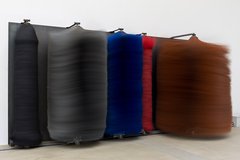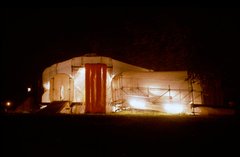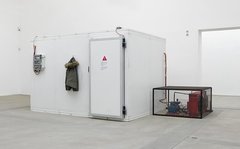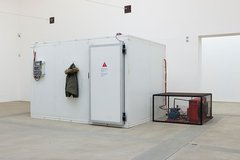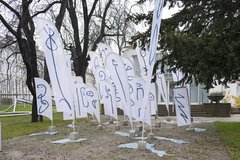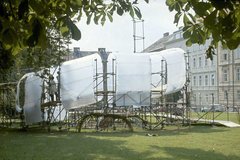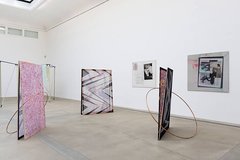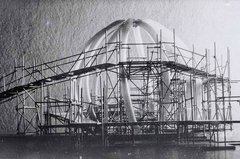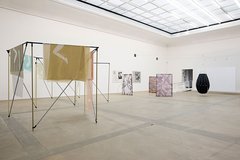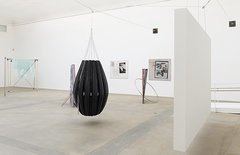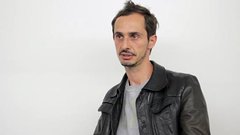Proposition for a fragmented reading (network of artists, exhibitions, and institutions in the space of trigon in 1960s and 1970s) by Branka Benčić, Direktor of Apoteka - Space for Contemporary Art and co-producer of the symposium accompanying trigon 67/17.
trigon as network
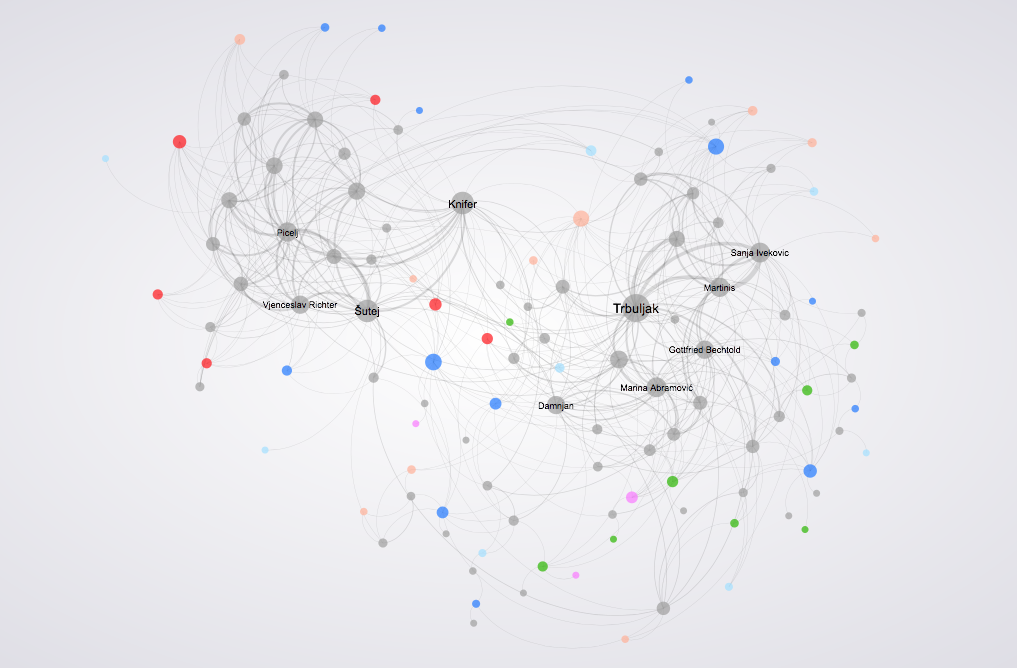
The cultural context and the space of the tri-nation biennial trigon since it’s establishment in early 1960s, along with current developments on the global art scene, opened up new possibilities for collaboration and exchange between Austrian, Italian and Yugoslavian artists, who shared an interest for contemporary artistic practices and recent developments in art – it opened a space for meeting, exchange of ideas and collaboration. In this way, decades before today’s global biennalization and festivalization of culture, in a wider context, as a biennial exhibition project and geopolitical space, trigon can be seen as a contribution to developments in contemporary art in South-East Europe, facilitating the internationalization of artistic space, mobility of the artists and cultural workers.
A look back on the impact of trigon reflects on narratives surpassing the boundaries of the respective countries. This essay along with related curatorial research aims to reflect how exhibitions and public manifestations such as trigon are inscribed into subsequent artistic, institutional and curatorial practices. Therefore trigon can be seen as a chapter contributing to explore and write exhibition histories in the framework of current revised views of the art historical canon, while the interest for the history of exhibitions and the contextualization of curatorial practices becomes increasingly present in art historical research. “It is now widely accepted that the art history of the second half of the twentieth century is no longer a history of artworks, but a history of exhibitions,” claims Julian Myers in On the value of history of exhibitions. [1]
Fragmented, unsystematic, inadequately documented and archived exhibitions, festivals, events, screenings… particularly those outside the leading artistic institutions, mayor centers or capital cities in different countries, still need to be researched and contextualized in order to be retold. When researching such histories, it is important to explore issues, pose questions and examine the ways in which public art events were inscribed in the art scenes from which they emerged from. It is important to explore their legacy regarding how and to what extent they influenced the establishment and program of art institutions and artistic practices, how they contributed to the overall formation of certain cultural influences, and the position they occupied in relation to ideological and economic frameworks and the context of the world of art.
A look back at the third iteration of trigon in 1967 may help to establish the contextual framework, taking into consideration a series of social, cultural, material conditions of artistic production and related developments in technology (such as the pioneer use audiovisual, electronic media, etc.) in the geopolitical region it occupies. Such framework is supposed to examine positions and transformations within the wider social, cultural and institutional sphere, in the confrontation between the viewpoints of history and art history, cultural, political frameworks and institutional critique. Thus, a contribution to researching trigon may serve as point to explore and reconnect histories of trigon as the background for similar events in the wider cultural context of the Trigon region, along with the cultural space of former Yugoslavia. Today we build up on the heritage that helped to shape collaborations as a transnational network and possibilities for a new generation of artists and curators, with a light of anticipation of emerging artistic, curatorial and institutional practices.
The research trigon as Network focuses on the selection of several trigon exhibitions that took place between 1967 and 1979 (six exhibitions), set in the common contextual framework with other international exhibitions, artist encounters, festivals and other artistic events on the territory of former Yugoslavia organized around the same time. These events were the meeting points of Croatian and international artists, such as the exhibition series New Tendencies (Zagreb, 1961-1973), Motovun Encounters (1972-1984), Brdo Encounters (1976-1983) and April Encounters (SKC Belgrade 1972-1977) serving as mapping nods. These events are considered as important meeting points and platforms for international exchange in former Yugoslavia. They established and maintained international connections between artists, ideas and practices, exhibitions and institutions, and are seen in relation to trigon exhibitions.
Please click here to see the map.
“During the 1960s and 1970s, cultural spaces across Ljubljana, Zagreb, Belgrade and other centres enter the focus of international interest and collaboration, as hubs of current media-based and conceptual approaches to art. The new cultural scene on the territory of former Yugoslavia was theoretically, socially and politically engaged and took shape of artists’ community organisations or their gathering around new or already existing institutions, such as the Contemporary Art Gallery (today the Museum of Contemporary Art) and the Student Centre in Zagreb, Bitef Festival at Atelje/Galerija 212 (1968-73) and, in particular, the Belgrade Student Centre, since 1971 launching the April Encounters – Festival of Expanded Media (1972-77) and other large-scale events. In this sense, the conceptual basis of the ‘new art practice’ consisted of theoretical, critical, alternative, multidisciplinary and media-engaged artists views.”[2]
A casual glance at the Trigon neighbourhood turns into a fixed gaze, focused but nevertheless fragmented, it forms the puzzle of different information, loosely connected facts from a scattered archive, stemming from impromptu methodology, singling out and highlighting details, steps and links. This map of fragments is incomplete and unfinished. It represents a starting point and a possibility for parallel readings, overlaps and nods. Not with the aim of creating a fixed official narrative and historiographical reconstruction, but rather to underline mutual relationships between fragments of the data map which is unsystematic and subjective, and which sheds light on some relations and connections in the cultural space it refers to. This view serves as backbone to examine the scope and contemporaneity of artistic production, to juxtapose the past and the present, different positions in art history and theory, cultural policies and institutional critique. The perspective to which it points out comprises parallel chronologies of trigon and related events, combining critical geography of art intertwined with social relations as cultural agents, while the project’s contextual framework develops a transnational perspective of institutional mechanisms in art.
In the 1960s and 1970s a change in the artistic cartography occurred due to a redefinition of artistic conventions and re-examination of the art system, emergence of innovative and alternative art forms took place, as well as new models of art production and presentation. The upcoming series of exhibitions trigon 67, 69 and 71 with organized around theme and concepts of “ambiente” (1967), “Architektur und Freiheit (architecture and freedom, 1969) and “intermedia urbana” (1971) focused on space and architecture in the wake of understanding sculpture in an ‘expanded field’ and the changes expounded by Rosalind Kraus in her essay Sculpture in the Expanded Field (1979), in which she approximates the idea of new production of ‘sculpture’ to architecture, space and landscape, referring to the practices of artists such as Robert Morris, Donald Judd or Richard Serra. This was the time of site-specific projects, spatial interventions equally in forming gallery environments and in accentuated abandonment of institutional boundaries, taking the form of installations and public space interventions, spreading around cities. These were formal, aesthetic and conceptual experiments, an intermedia approach to space.
In that period, the trigon exhibitions featured artists like Vjenceslav Richter and Miroslav Šutej, Gianni Colombo, Luciano Fabro, Enzo Mari, and Marc Adrian, Josef Pillhofer, Ugo la Pietra, Superstudio, Ivan Kožarić – artists who had exhibited earlier at New Tendencies, followed by the an emerging generetion with artists such as Sanja Iveković, Jagoda Kaloper, Boris Bućan, Braco Dimitrijević, Dalibor Martinis, Goran Trbuljak, Gorki Žuvela – who exhibited at the project Mogućnosti za 71 (Possibilities for 71) in Zagreb the same year.
The exhibition Mogućnosti za 71 in Zagreb, organised by the Contemporary Art Gallery (today Museum of Contemporary Art), marked the act of leaving the gallery/museum space, highlighting the needs of the new generation of artists and audience for interventions in the real, designed and organised urban space, which thus became a platform and playground for artistic explorations. This way art activated the urban environment, specific locations in Zagreb’s Old Town, engaging the observer. Developing along a similar trajectory, the same year in Zagreb the section Prijedlog 6 (Proposal 6) of the Zagreb Salon featured a theme project City as a Space of Sculptural Action.
In the wake of events and changes occurring in the early seventies in the international context, trigon is seen connected with the pioneering practices of new media, video and photography.
The anthological trigon 73 Audiovisuelle Botschaften was one of the first video art exhibitions in Europe, revolving around the acknowledgment and understanding of the creative role of new media and the creative benefits of television for artistic experiments (the exhibition TV as a Creative Medium was organised in New York City in 1969).
trigon 73 featured Nuša and Srečo Dragan, Boris Bućan, Sanja Iveković and Dalibor Martinis, Goran Trbuljak, Ilija Šoškić, Gianfranco Baruchello, Franco Vaccari, Gottfried Bechtold, Valie Export, Peter Weibel, Richard Krieche – artists that had contributed to the history of video art and media art in general.
Early video evolved along three lines, with interests in many cases intertwining or overlapping: directing the interest to the media analysis, social comment, . registering the process-oriented as the most common forms of the use of video in early artist practices. The video medium has, right from the start, suited the artists focusing on performance and body art, conceptual, land art practices, analytical, linguistic, visual and political practices, different media explorations, from repetition and time perception to duration.
The acknowledgment of video as a new medium occurred with enthusiasm among artists, despite the difficulties in production, definition, research or inclusion in the academic curriculum. Due to a lack in video equipment in the former Yugoslavia, early artist video works were mainly made abroad, art exhibitions like trigon 73, or using the equipment provided by foreign galleries, as was the case with the artists meetings in the town of Brdo in Istria, organised by the Krinzinger Gallery from Innsbruck (today in Vienna), or in Motovun organized by the Galleria del Cavallino from Venice. For that reason, the striving of a certain number of Yugoslav artists to work with video could come to fruition only sporadically. In the catalogue of the IV Motovun Encounter, Marijan Susovski claims that at the time only two institutions in Yugoslavia covered the evolution of video art – Contemporary Art Gallery in Zagreb (today’s Museum of Contemporary Art) and SKC Student Cultural Centre in Belgrade.[3]
There was an ongoing interest of the up-and-coming generation of artists in video and photography, installation, performance art, first person speech, body art, language, visual poetry, minimalist sculpture, within conceptual art. Along that line, conceptually the themes of trigon revolved around the matters of identity (trigon 5: identity – alternative identity – anti-identity), with artists such as: Franco Vaccari, Michelangelo Pistoletto, Giulio Paolini (the Italian selection was curated by Umbro Appolonio), Peter Weibel was among the Austrian representatives, while Vera Horvat Pintarić selected Miroslav Šutej, Vjenceslav Richter, Radomir Damnjan, Andraž Šalamun. trigon 77 focused on creative process and featured the following artists: from Italy Giovanni Anselmo, Dadamaino, Fabio Mauri; from Yugoslavia Jovan Čekić, Boris Demur, Goran Đorđević, Julije Knifer, Obitelj iz Šempasa (Šempas Family), Andraž Šalamun; from Austria Gottfried Bechtold, Arnulf Rainer; while Trigon 79 revolved around masculine vs. feminine and featured the artists Nuša and Srečo Dragam, Sanja Iveković, Dalibor Martinis, Neša Paripović (YU), Gottfried Bechtold (A), and visiting artists Marina Abramović and Ulay.
Recognising the current manifestations in art such as the issues of identity, feminist critical discourse, process-oriented art, the context of dematerialisation of the work art, pioneer use of the video medium, trigon played an active role in the networking of ideas. In that sense we can notice coherences and connections with the artists who took part in trigon exhibitions and the related events in the major cities in Yugoslavia - Zagreb, Belgrade, mapped by the research trigon as Network.
Synchronicities and correspondences as a sign of the shared cultural climate is also visible in some of the Motovun Encounters, and among the most significant artistic meetings are those taking place in the decade between 1974 and 1979, encompassed under the topics Urban Intervention Project (1974), Identity (1976), and New Landscape, Photography and Polaroid (1977). The Motovun Encounters included Yugoslavian and Italian artists such as Marina Abramović, Ivan Ladislav Galeta, Tomislav Gotovac, Sanja Iveković, Dalibor Martinis, Julije Knifer, Ivan Kožarić, Dora Maurer, François Morellet, Michele Sambin, Duba Sambolec, Mladen Stilinović, Miroslav Šutej, Ulay, Goran Trbuljak, Luigi Viola and others. The conventions were co-organised by Galleria del Cavallino from Venice, Ethnographic Museum from Pazin and Contemporary Art Gallery (today’s Museum of Contemporary Art) from Zagreb, joining the project in 1976. In Istrian peninsula, close by another encounter occurred at the same time in a village Brdo - Brdo Encounter (1976) organised by Ursual Krinzinger and it gathered artists from Yugoslavia and Austria: Gottried Bechtold, Heinz Cibulka, Ernst Caramelle, Mladen Stilinović, Marina Abramović, Boris Demur, Goran Trbuljak.
The April Encounters – Expanded Media Festival taking place between 1972 and 1977 at SKC Student Cultural Center Belgrade, was one of the venues concentrated on many relevant issues regarding recent developments in art and the nature of contemporary art itself, exploring artistic positions and manifestations, it was a meeting point where the local scene crossed paths with international guests.
Ješa Denegri speaks of the April Encounters as “interventions of uncodified convolutions of different means, short-lived and vital outreaches from the fixed spheres of expression. The April Encounters gathered the accomplishments of those who represent the leading authors in conceptual art, body art, behavioural art, video art, photography and performance art on the current Yugoslav art scene and prominent guests from the international scene.”[4] The April Encounters included Peter Weibel, Franco Vaccari, Gianfranco Baruchello, Joseph Beuys, Simone Forti, John Baldassari, as well as curators and critics like Germano Celant, Achille Benito Oliva… Denegri points out that it was a time when the artist’s presence was more important than the permanent presence of an art work, and critics’ opinion and communication and event organisation more important than a written text. In that sense, new formats were examined, such as the festival format, focusing on the artistic event, not the object.
In a period following the New Tendencies, above mentioned up-and-coming artists took part in the artistic events that followed in the 1970s – Motovun Encounters, Brdo Encounter, April Encounters. They exhibited at the SKC Gallery in Belgrade and Contemporary Art Gallery - today Museum of Contemporary Art in Zagreb, and a majority of the Yugoslav artists who participated in trigon exhibitions in the 1970s were also represented at the seminal 1978. exhibition New Art Practice (Nova umjetnička praksa) at the GSU (MSU - Museum of Contemporary Art in Zagreb). Bechtold and Braco Dimitrijević took part at Documenta 5 in 1972, OHO and Italian artists Michelangelo Pistoletto and Giovanni Anselmo at the Information exhibition at MoMA (1970) and the exhibition under the title Arte Povera was organised in Italy. In a similar perspective, the earlier exhibition The Responsive Eye at MoMA in 1965 was pertinent to the earlier generation of artists who took part in the New Tendencies.
On such background we may see trigon as network, as a place to explore and reconnect histories of trigon and related events in the wider cultural framework of the trigon region, along with the cultural space of former Yugoslavia, building up on the heritage that fostered a transnational network of artists as well as shaping curatorial and institutional practices.
Appendix
Please click here to see the following map.
Proposition for a Map of trigon is an overview of the fragmentary map of exhibitions, artists, and artistic occurrences in the Trigon region in the 1960s and 1970s, focusing on similar ideas, concepts, common themes, and contexts. It provides a fragmentary insight into the exhibitions like New Tendencies (Zagreb), trigon (Graz), Motovun Encounters (Motovun, Istria), April Meetings (Belgrade), meetings at Brdo (Brdo, Istria), which can be identified as the points of exchange between artists from Yugoslavia, Austria, and Italy.
The perspective on trigon and related events therefore combines a critical geography of art connecting artists, institutional and social relations as cultural subjects. Trigon is seen as a transnational trajectory of the institutional mechanisms of art.
[1] Julian Myers: On the value of history of exhibitions, The Exhibitionist, no. 4, 2011.
[2] Biljana Tomić: Brdo “druge linije” (Brdo and the “second line”), in: Brdo 1976 – 2016, 56th Annale, Poreč, 2016.
[3] Marijan Susovski: Catalogue, IV Motovun Encounter, Galleria del Cavallino, Motovun 1977.
[4] Ješa Denegri: Student Cultural Centre as an Art Scene, SKC, Belgrade, 2003.
